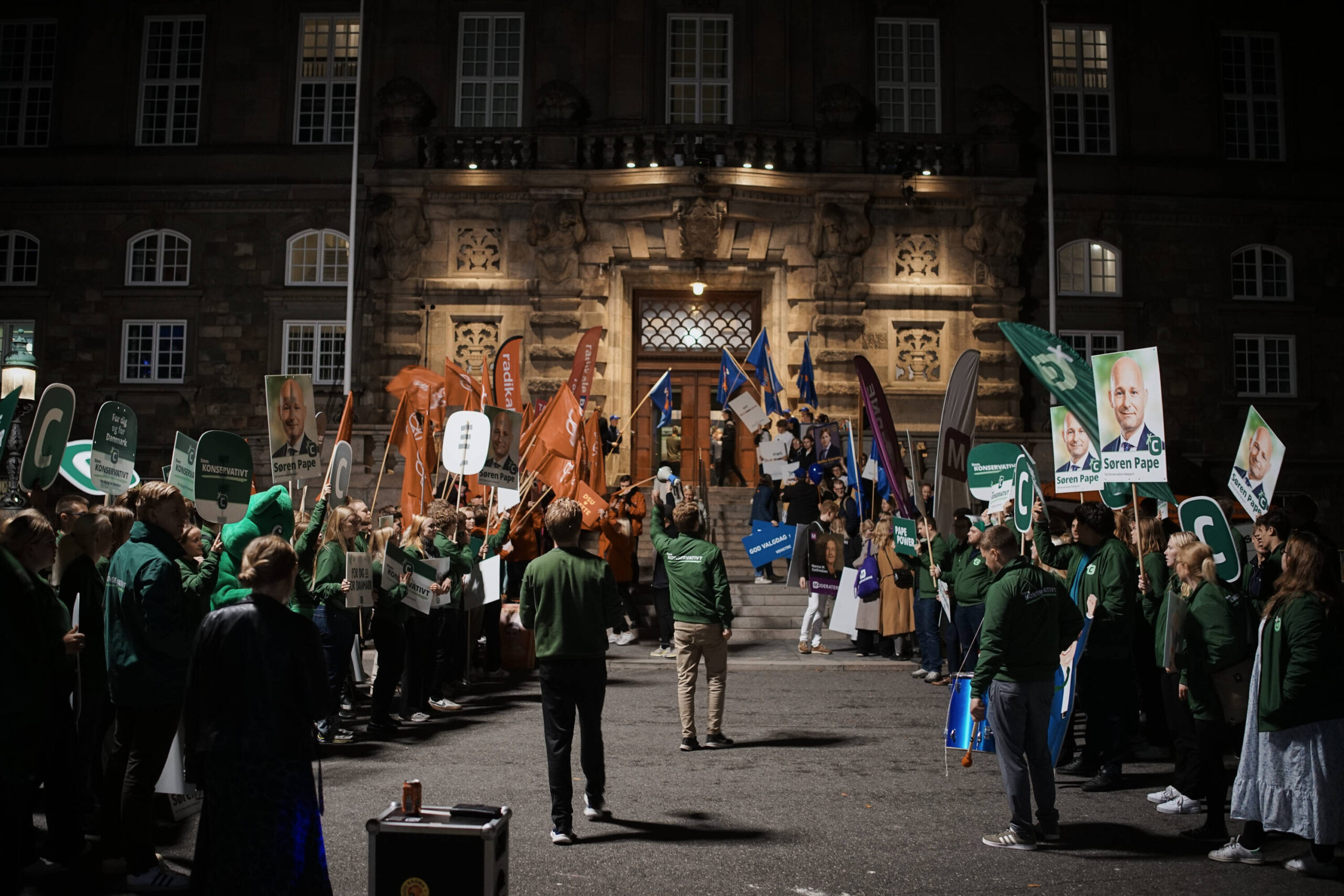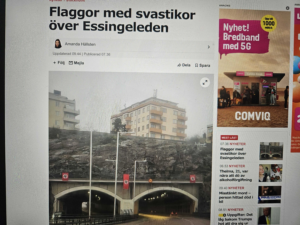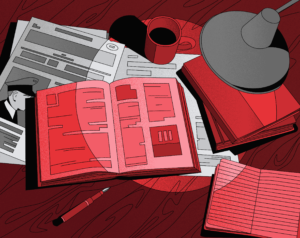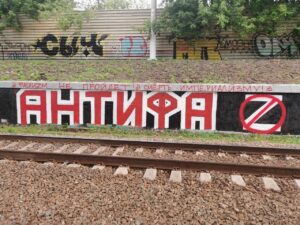This article was published here by the Rosa Luxemburg Foundation and was written by the Redox Research Collective.
The calendar reads 2025, but to understand the state of the parliamentary hard right in Denmark, it is necessary to travel some six years back in time, to the days when the Danish government relied on the support of the far-right Danish People’s Party to govern, and when a flatcap-wearing man, convicted of racism and with a strong social media appeal, became a household name, and heralded a radical change in the political map of Denmark.
That man – Rasmus Paludan – and his micro party Stram Kurs (“Hard Line”), were among the most widely discussed topics in Denmark during the first half of 2019. His mini-demonstrations, where participants entered marginalised neighbourhoods and burned the Quran, were livestreamed on the party’s Facebook account, and he received massive press coverage – and faced widespread protests. This coverage helped him secured him a significant number of voter declarations, practically guaranteeing him the 20,000 signatures necessary to run for parliamentary election in Denmark.
Liberal appeals to the centre
As Paludan’s far-right provocations intensified and grew in profile, then-Prime Minister Lars Løkke Rasmussen (of the ruling liberal party Venstre, Denmark’s main centre-right liberal party) called for elections to the Folketing (Danish parliament) to be held on Constitution Day, June 5 – the same day as the European Parliament (EP) election. In the middle of the election campaign, however, the Prime Minister dropped a veritable bombshell that threatened to topple Denmark’s long-established political certitudes.
Without warning, he published a book titled ‘The Moment of Liberation’, in which he advocated the formation of a centrist government consisting of parties from both the centre-right and centre-left, to keep both the far-right and far-left “extremes” out of power. In Denmark, long dominated by coalitions of the “red” (broadly left-wing) and “blue” (right-wing) parties, such a suggestion was a radical, and contentious, departure. It was also not a little ironic, as Rasmussen’s own government depended on the support of the far-right to rule. The move was unsuccessful – the election resulted in the “reddest” Folketing (Danish parliament) since the 1970s, with the Social Democrats forming a new left-wing government.
Mixed Fortunes on the Far-right
While the 2019 election campaign was disproportionately dominated by Rasmussen’s book and debates around Stram Kurs and Paludan’s theatrics, another new far-right party, Nye Borgerlige (“New Right”), had become eligible to run for election. Originating in a small rightwards split from the Conservative party in 2015, Nye Borgerlige’s platform combining anti-Muslim xenophobia with aggressively anti-government “liberalism” passed largely under the radar, with Paludan’s theatrics holding the media’s attention. Ultimately, Paludan and Stram Kurs, with 1.8 percent support, fell narrowly short of Denmark’s 2 percent threshold, but Nye Borgerlige sneaked into parliament on just 2.4 percent of the vote.
In the final count, a total of 146,000 Danes had voted for the two political parties which at this point were either somewhat (Nye Borgerlige), or very (Stram Kurs), far to the right of Denmark’s long-established far-right face, the Danish People’s Party. Rising support for these parties coincided with a collapse in support for the Danish People’s Party, which had a terrible election, losing over half of its seats. In part this was due to persistent accusations of the fraudulent use of EU funding (the so-called MELD/FELD case), but both Stram Kurs and Nye Borgerlige also appealed, successfully, to more radical right supporters of the Danish People’s Party, splitting the far-right vote.
Liberals Divided
The Danish centre was also facing growing division. As well as upsetting Denmark’s political applecart, the publication of Rasmussen’s book ‘The Moment of Liberation’ also marked the start of an internal collapse in its dominant liberal party, Venstre, and the creation of two new parties – one of the political centre, the other of the populist hard right. While Venstre’s vice-chairman quickly and publicly dismissed party leader’s Rasmussen’s new political strategy, leading to rising tensions, only a few months after the election, both chairman and vice-chairman had resigned from their positions.
Then in early 2020, a parliamentary legal investigation was established to determine whether Venstre’s controversial former Integration Minister Inger Støjberg – a notorious anti-immigration hardliner – had violated the right to individual assessment when she issued a press release in 2016 that ordered the separation of asylum-seeking couples arriving from Syria where one of them was under the age of 18. This investigation would lead to a further splintering of Denmark’s political landscape.
New Parties Form
In 2021, the commission concluded that Støjberg’s action was indeed illegal, and a majority of the Danish Parliament voted in favour of impeachment proceedings against her. This included most of her colleagues in Venstre, causing Støjberg to angrily quit the party, which she claimed was “moving at a high pace” away from her own values on immigration. Støjberg was subsequently found guilty of wilful violation of the Ministerial Responsibility Act and was sentenced to 60 days imprisonment, which she served under house arrest with an ankle monitor.
Lars Løkke Rasmussen also quit Venstre in early 2021, and the party had now lost its two biggest vote catchers from the 2019 election. Venstre’s crisis deepened in June 2022, when Rasmussen finally launched a new party, Moderaterne (“The Moderates”) that fully endorsed his centrist vision of Danish politics. At the same time, Støjberg – spurned by her former colleagues – founded her own party, Danmarksdemokraterne (“The Denmark Democrats”). Her long-anticipated new party – espousing Støjberg’s brand of xenophobic right-wing populism – was an immediate success, collecting the required 20,000 voter declarations in only a few days.
Far-right in meltdown
It wasn’t just Venstre that went into meltdown between the 2019 and 2022 elections, however. Having already lost more than half its parliamentary seats in 2019, the Danish People’s Party’s woes were further compounded by a poor result in the municipal elections in the autumn of 2021. In the aftermath of the vote, party leader Kristian Thulesen Dahl faced strong criticism for the precipitous change in fortunes, and in January 2022 he announced that he would step down as chairman.
Controversial MP, and former MEP, Morten Messerschmidt – who had been considered the natural heir for several years – was elected as the new chairman, but it was not the long-expected coronation he may have hoped for. He faced two competitors for the role, and the result only helped stoke the party’s many growing internal conflicts, leading some MPs to jump ship to Inger Støjberg’s new Denmark Democrats. One of Messerschmidt’s rivals for the leadership – Martin Henriksen –would later go on to become leader of rival far-right party Nye Borgerlige.
Hard times for Hard Line
For Rasmus Paludan, the narrowly unsuccessful 2019 general election was to be the high-water mark. Nonetheless, winning 1.8 percent of the vote had secured the party millions of kroner in funding, providing it with enough money to cover the costs of a party organisation and activities until the following election. The party even held a national congress six months after the 2019 election, gathering close to 100 members in Christiansborg, the castle that houses the Danish Parliament.
In early 2020, however, Stram Kurs was banned from collecting voter declarations for over two years due to the fraudulent use of the digital voter declaration system. Among other things, this ban meant the party could not run in the 2022 election. They tried briefly to collect signatures under the name Hard Line, but after falling out with the owner of the name, Paludan had to start over. A brief attempt to do so under the name ‘No to Islam in Denmark’ was also unsuccessful. While Paludan is once again allowed to use the name Stram Kurs, at the time of writing he has only 560 signatures and the party is now practically non-existent, with no life beyond Paludan’s social media profile.
Right-wing demolition derby
In the autumn of 2022, there was yet another Danish parliamentary election. This time it was clear that Rasmus Paludan’s Stram Kurs would not be able to gather the support necessary to run, but the stage was nonetheless set for a right-wing demolition derby: the Danish People’s Party hoped to recover from its crisis, Nye Borgerlige aimed to capitalise on their strong support in the polls, and Inger Støjberg was seeking re-election after her conviction, now as leader of her own party of the xenophobic hard-right.
For the Danish People’s Party, the humiliation was near total, barely sneaking back into parliament with only 2.6 percent of the vote, a far cry from its highwater mark of 25 percent in the 2014 European elections. Nye Borgerlige gained ground, with 3.6 percent, but their disappointment was evident – six months earlier opinion polls had given the party 8.5 percent support. Instead – as widely predicted – the big winner from the hard-right was Inger Støjberg, whose Denmark Democrats won a hefty 8.1 percent of the vote. The combined hard-right vote was also well below the 25 percent the Danish People’s Party had once received, suggesting a moment had passed.
Lars Løkke’s redemption
Ultimately, none of the three right-wing parties – Denmark Democrats, Nye Borgerlige, and the Danish People’s Party, holding just 25 seats between them – was able to influence the composition of the government either. And although the Social Democrats could have led a (narrow) left-majority coalition, they chose instead to form a “government over the middle” in coalition with Venstre and The Moderates, albeit also with a slim majority. In this way, the vision that cost Lars Løkke Rasmussen his role of chairman of Venstre in 2019 was finally realised, with him once again in a leading role – now as Foreign Minister.
New Right Crisis
The 2022 election foreshadowed yet further discord for the Danish hard right. In January 2023 – only two months after securing a relatively successful, if disappointing, election result – Pernille Vermund, founder and chair of Nye Borgerlige, resigned. It soon became clear that Lars Boje Mathiesen would replace her, leading his rival for the role, Mikkel Bjørn Sørensen, to pre-emptively leave the party and join the Danish People’s Party. The move proved somewhat hasty: only 30 days after his appointment the new chairman was history, as a dispute over financial matters saw him ousted, first from the role, and then from the party.
Nye Borgerlige – which by this point had now lost 3 of its 6 MPs (two of them defections to the Danish People’s Party) – was in open meltdown. Pernille Vermund stepped into the leader’s shoes once again to restore calm, but it was short-lived. In January 2024, a year after first having resigned as chairman, Vermund announced that the party’s 3-person parliamentary group intended to fold and that they recommended to Nye Borgerlige’s board that the party itself be dissolved as well. Vermund then promptly left to join the ultra-liberal party, Liberal Alliance, which had begun tacking to the right.
An Identitarian Trojan Horse
Nye Borgerlige’s grassroots disagreed with the decision to close the party down, however, and a small but stubborn group of members managed to organise a relaunch. At an extraordinary national conference in April 2024, where Vermund & her allies had hoped the party would be wound up, the proposal was rejected. Instead, a new chairman was elected: none other than Martin Henriksen, who had left the Danish People’s Party after losing the chairmanship battle with Morten Messerschmidt in 2022.
The election of Henriksen was also noteworthy due to his close ties to the neo-fascist organisation Generation Identitær (“Generation Identity”). He was a guest at Generation Identity’s secretive Friday bar events, maintained close contact with its members on social media, and was photographed with members of Generation Identity at Nye Borgerlige’s 2024 party congress. While Henriksen announced his retirement from politics in April 2025 – only a year after taking on the leadership role – Nye Borgerlige’s prolonged crisis appears to have created an opening that the even more radical Generation Identity has capitalised on. Generation Identity members have taken on leading roles in the party, as both employees and elected representatives, and are contributing to the party’s policy development.
Danish People’s Party rebuilding
From 1995 to 2019, the Danish People’s Party had been the only far-right party in the Danish Parliament. Slowly but surely, the party support grew, peaking in 2014, when its anti-immigrant, right-wing populist rhetoric received almost one in every four votes cast across Denmark. Yet even as new rivals sprung up to its right, the Danish People’s Party found itself robbed of its core policies by none other than the Social Democrats, who fought and won the 2019 election on a combination of hardened rhetoric on migration and promises to increase public spending.
After two disastrous elections, in 2019 and 2022, the hard-right party was decimated, reduced to only 5 seats (down from 37 in 2015), and the party organisation has been severely cut back. Kristian Thulesen Dahl, who had curbed some of the party’s more strident rhetoric, resigned at the start of 2022, and under new leader Morten Messerschmidt the party has returned to a more aggressive, xenophobic tone on topics such as migration and Islam.
With many internal critics having switched to the Denmark Democrats, the Danish People’s Party’s internal conflicts are increasingly a thing of the past, and the party is in the process of rebuilding. The party has also benefited greatly from Nye Borgerlige’s recent meltdown, with MPs Mikkel Bjørn Sørensen and Mette Thiesen – both high profile operators known for their attacks on immigrants, Muslims, refugees, and “woke”-ism – defecting from Nye Borgerlige to the Danish People’s Party.
Støjberg’s revenge
With Danish People’s Party and Nye Borgerlige in disarray, and Paludan increasingly irrelevant, the big winners of the 2022 election and its aftermath on the hard right were Inger Støjberg and her Denmark Democrats. The party’s 8.1 percent vote share and 14 seats now make it the second largest right-wing party in Danish parliament – and the largest on the hard right. In part, the reason for this success can be found in the Denmark Democrats’ platform – radical national conservativism with a focus on Danish sovereignty, regional rights, Euroscepticism (while stopping short of calling for an EU exit), and a highly restrictive immigration policy – which bridges the space between the existing far-right, such as the Danish People’s Party, and more traditional conservative forces. The party’s main drawcard, however, is the highly popular character of Støjberg herself.
Part of Støjberg’s attraction is her track record of stirring controversy. As Minister for Immigration and Integration, she tightened Denmark’s immigration system in an often extreme manner. In 2016, she proposed a contentious “jewellery law” allowing authorities to seize valuables from refugees “to fund their stay” in Denmark. The law was criticised by human rights organisations and in the global media, both for attacking refugees, and for its resemblance to Nazi confiscations of Jewish gold and valuables during the Holocaust. In 2017, Støjberg posted a photo to Facebook celebrating the passage of 50 restrictions on immigration with a cake and candles. Already mentioned, of course, was her order to arbitrarily separate asylum seeker couples where one was a minor, a move that ultimately saw her impeached and convicted.
A Danish Trump?
Støjberg’s 2022 election campaign also featured Trump-inspired rallies that drew strong support in rural areas. Many of the attendees had been participants in earlier tractor protests targeting the government’s corona measures, where Støjberg had frequently echoed Donald Trump’s call to “drain the swamp” in her speeches. Some of Støjberg’s supporters have proven too extreme even for her, however. At last year’s Hjallerup Market (Europe’s largest horse market), Støjberg autographed the stomach of a young man who then revealed a large Nazi SS tattoo on his chest. Støjberg promptly distanced herself from the man and his tattoo, but the incident – while apocryphal – says a lot about who the Denmark Democrats appeal to.
In the 2024 European Parliament elections, the Denmark Democrats received 7.4 percent of the vote, electing one MEP, Kristoffer Storm (another former long-term member of the Danish People’s Party). Despite describing itself as “centre-right”, the Denmark Democrats have joined the European Conservatives and Reformists (ECR) group in the European Parliament, where they sit alongside the likes of the Sweden Democrats, Poland’s Law and Justice Party, and Giorgia Meloni’s Brothers of Italy, among others. The Danish People’s Party – the other Danish hard right party with an MEP– sits with the Patriots for Europe group, alongside the far-right Freedom Party of Austria, France’s National Rally, and Victor Orban’s Fidesz.
The patient died, but the operation was successful
While the current centrist government coalition holds, and the far-right of Denmark’s political spectrum continues to consume and reshape itself, the Danish People’s Party, Nye Borgerlige and the Denmark Democrats have limited direct political influence. Even so, their policies are far from forgotten. In recent years, Denmark’s Social Democrats have accelerated their decades-long trend to the right on topics such as refugees, immigration and integration, effectively – almost blatantly – stealing the far-right’s clothes on these topics. In the process, a number of younger men from the party’s right wing have built a profile for themselves on the issue.
This includes Frederik Vad, former chairman of the Social Democrats’ youth wing and now an MP and immigration spokesperson for the Social Democrats. In April 2024, he gave a controversial speech in the Danish parliament arguing there was a key “values struggle” in the immigration debate that had been overlooked. According to Vad, people with foreign and immigrant backgrounds – not matter how well integrated they may appear – are actively using their positions in the community to undermine Danish society from within. Vad referred to a Swedish report that he claimed showed “how tens of thousands of people in clans and gangs and in certain ethnic communities have infiltrated, and I quote: all significant sectors of Swedish society.” He argued that similar trends could be seen in Denmark, necessitating even tighter immigration policies.
With friends like these…
Vad was heavily criticised for the speech and was forced to admit that he had used the report wrongly after two of its authors publicly rejected his interpretation of their findings. Even so, Vad maintained that his central argument was still true, describing it as a ”third realisation” in the Social Democrats’ immigration policy. The following month, Social Democratic Minister for Immigration and Integration Kaare Dybvad Bek also backed Vad’s proposal and announced that an investigation into negative social control committed by public employees was on its way. The line is supported by the party leadership, up to and including Prime Minister Mette Frederiksen, who had spoken out in support of Vad when criticism of his xenophobic speech was at its peak.
Unsurprisingly, Vad’s racist ”realisation” was seized upon by neo-fascists of the far-right group Generation Identity, who showed up outside a conference held by Vad in the parliament buildings on this aspect of the immigration debate. Generation Identity used the occasion to campaign for the “remigration” of people of foreign background out of Denmark, proposing this as a ”fourth realisation” for the Social Democrats to adopt. In reality, Danish migration policy sometimes drifts worryingly close to such a position already.
With many immigration policies of the far-right now adopted by the centre (and even the ostensible “centre-left”) of Danish politics, the future looks grim. And while adopting their politics might take the wind out of the sails of the far-right parties for a while, prolonging their turmoil a little, it is only a matter of time before they regroup, and a new government of the right is elected that relies upon one or more of the hard right parties to form a majority. With the groundwork already laid, the next tranche of attacks on migrants can only be worse. But, given that the Social Democrats helped to lay much of that groundwork, it remains an open question if a government of left will be much better.
Redox Research Collective is a left-wing anti-fascist research group that collects information and publishes news and reports about the Danish far-right. Redox is registered with the Danish Press Council and publishes at https://redox.dk/








